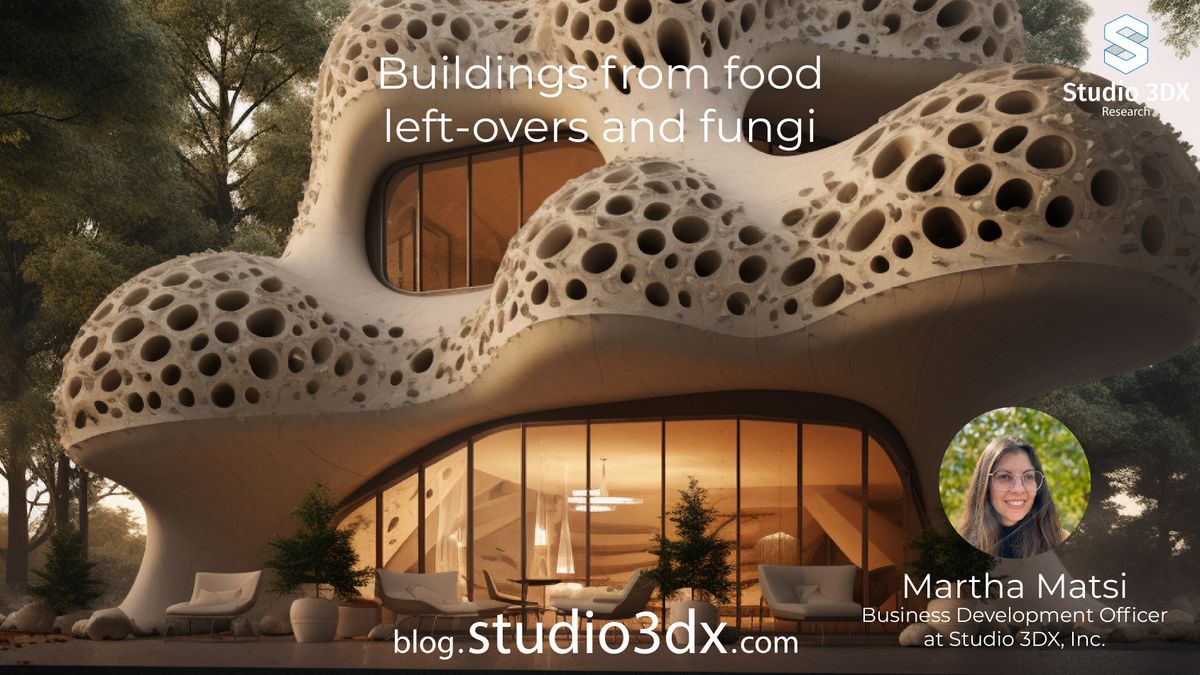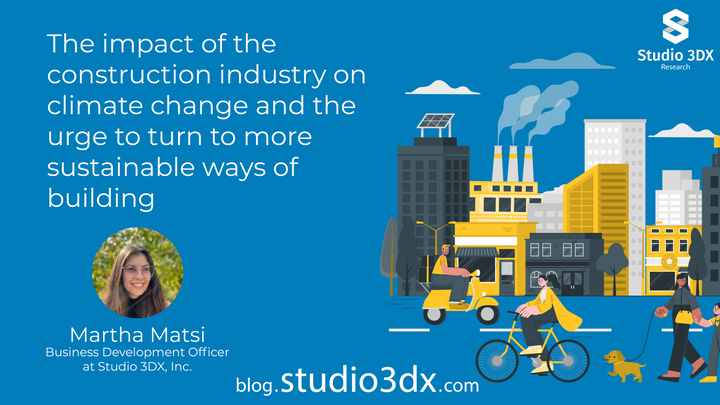Buildings from food left-overs and fungi
Cement production accounts for approximately 8% of global CO2 emissions, according to the International Energy Agency (IEA). It involves the combustion of fossil fuels, typically coal or natural gas, to provide the high temperatures needed for the chemical reactions.

Buildings are responsible for a significant portion of global greenhouse gas emissions. According to the United Nations Environment Programme (UNEP), buildings account for approximately 39% of global energy-related carbon dioxide (CO2) emissions. The operational phase of a building's life cycle, including energy use for heating, cooling, lighting, and appliances, contributes to the majority of its carbon footprint. In non-sustainable buildings, inefficient heating, ventilation, and air conditioning (HVAC) systems, poor insulation, and outdated technologies can lead to higher energy consumption and emissions. Apart from these operational emissions, however, the construction phase and materials used in non-sustainable buildings can also contribute to a significant carbon footprint. The production, transportation, and extraction of construction materials, particularly those with high carbon intensity like concrete and steel, can result in substantial embodied carbon emissions.
Sustainable buildings on the other hand are designed, constructed, operated, and maintained in a way that minimizes their impact on the environment and promotes resource efficiency, human health, and well-being. Key features and considerations of sustainable buildings may include the use of renewable energy sources such as solar panels or wind turbines to generate clean electricity. Efficient lighting systems, appliances, and HVAC (heating, ventilation, and air conditioning) systems may also be incorporated in order to prioritize energy conservation. The use of water-efficient fixtures, rainwater harvesting systems, and recycling or reusing water for irrigation or non-potable purposes can also contribute to the reduction of water consumption.
Shifting from Cement to Sustainable Building Materials
Cement production accounts for approximately 8% of global CO2 emissions, according to the International Energy Agency (IEA). It involves the combustion of fossil fuels, typically coal or natural gas, to provide the high temperatures needed for the chemical reactions. During this process, limestone (calcium carbonate) is heated and converted into lime (calcium oxide), releasing carbon dioxide (CO2) as a byproduct. This is referred to as process emissions.
Sustainable buildings emphasize the use of environmentally friendly and non-toxic materials, such as recycled or reclaimed materials, sustainably sourced wood, low VOC (Volatile Organic Compounds) paints and finishes, and materials with a reduced carbon footprint.
There are a few examples of buildings that showcase the use of sustainable materials such as Cross-Laminated Timber (CLT), glulam, lightweight panels, glass, and steel which offer a lower carbon footprint compared to traditional concrete and provide strength, durability, and energy-efficient properties:
The Bullitt Center, Seattle, United States: The Bullitt Center is a six-story office building constructed with a focus on sustainability and reduced environmental impact. It utilizes Cross-Laminated Timber (CLT) as the primary structural material instead of concrete. CLT is a sustainable and renewable material made from layers of wood panels, providing strength and durability while significantly reducing the carbon footprint compared to concrete and steel. Glulam (glue-laminated timber) is another wood product used in the Bullitt Center. It is made by bonding layers of timber together with adhesives, creating beams and columns with enhanced strength and stability. By substituting cement with wood, emissions can be reduced by approximately 0.82 tons of CO2 per ton of material, promoting sustainable forestry practices and ensuring a continuous supply of this renewable resource.
Bosco Verticale (Vertical Forest), Milan, Italy: The Bosco Verticale is a pair of residential towers featuring extensive vegetation on the façade, which helps improve air quality, reduce the urban heat island effect, and provide insulation. The towers utilize a combination of lightweight and sustainable materials for construction, including prefabricated panels and aluminum frames, minimizing the need for cement. While not a construction material in the traditional sense, the extensive vegetation on the façade is a key feature of the Bosco Verticale. It consists of trees, shrubs, and plants, which are selected and maintained to provide numerous environmental benefits.
The Crystal, London, United Kingdom: The Crystal is a sustainable building designed to be a center for sustainable cities. The building's envelope utilizes glass and steel: the glass façade not only adds aesthetic appeal but also allows natural light to penetrate the building and reduces the need for artificial lighting during the day. In addition the steel provides structural support and can be sourced with lower embodied carbon. In fact by replacing a ton of cement with an equivalent amount of recycled steel, we can save approximately 0.98 tons of CO2 emissions.
Innovative Solutions: Food Waste and Fungi
An area of active research and development is the use of eco-friendly alternatives for construction such as food-waste or fungi-based materials.
Researchers have found that incorporating coffee grounds into concrete mixtures can improve properties such as thermal conductivity, water absorption, and workability. Coffee grounds can be used as a filler material, replacing a portion of sand or fine aggregate in the concrete mix. Other studies have shown that biowaste ashes, such as rice husk ash and palm oil fuel ash could be used as partial replacements for cement and contribute to improved strength, durability, and reduced environmental impact.
Kota Machida and Yuya Sakai, researchers from the University of Tokyo in Japan have developed a technique through which it is possible to produce cement from food waste! They have successfully made cement using tea leaves, orange and onion peels, coffee grounds, Chinese cabbage and even lunchbox leftovers.
Another interesting alternative construction material is that of Mycelium, the root-like structure of fungi, that can be harnessed to create building materials. Mycelium grows to form a dense network that binds the substrate together, resulting in a solid material which is lightweight, biodegradable, and has insulating properties, making it suitable for various building applications.
A real life example is the Hy-Fi tower, which was constructed for the 2014 Young Architects Program at MoMA PS1 in New York, using a combination of biodegradable bricks made from corn stalks and a specially developed reflective material called "Mushroom® Materials" by Ecovative Design.
Mushroom® Materials are created by growing mycelium on agricultural waste products like corn stalks. The mycelium grows and binds the waste particles together, forming a solid and lightweight material used to create biodegradable bricks. Mycelium-based materials can reduce CO2 emissions by up to 90% compared to cement, representing a significant leap forward in sustainable construction practices.
A Path to Reduced CO2 Emissions
Transitioning from cement to alternative materials such as steel, glass and wood we get the opportunity to revolutionize the construction industry and significantly reduce our carbon footprint. In addition, innovative solutions utilizing food waste and fungi also show tremendous promise. By diverting organic waste from landfills and incorporating it into construction, we not only reduce CO2 emissions associated with cement production but also tackle the issue of waste management.
While the specific emission reduction numbers may vary depending on the application and manufacturing processes, the overall potential is undeniable.
By incorporating these alternatives into architectural designs, engineering practices, and policy frameworks, we can revolutionize the construction industry and pave the way for a greener future.


